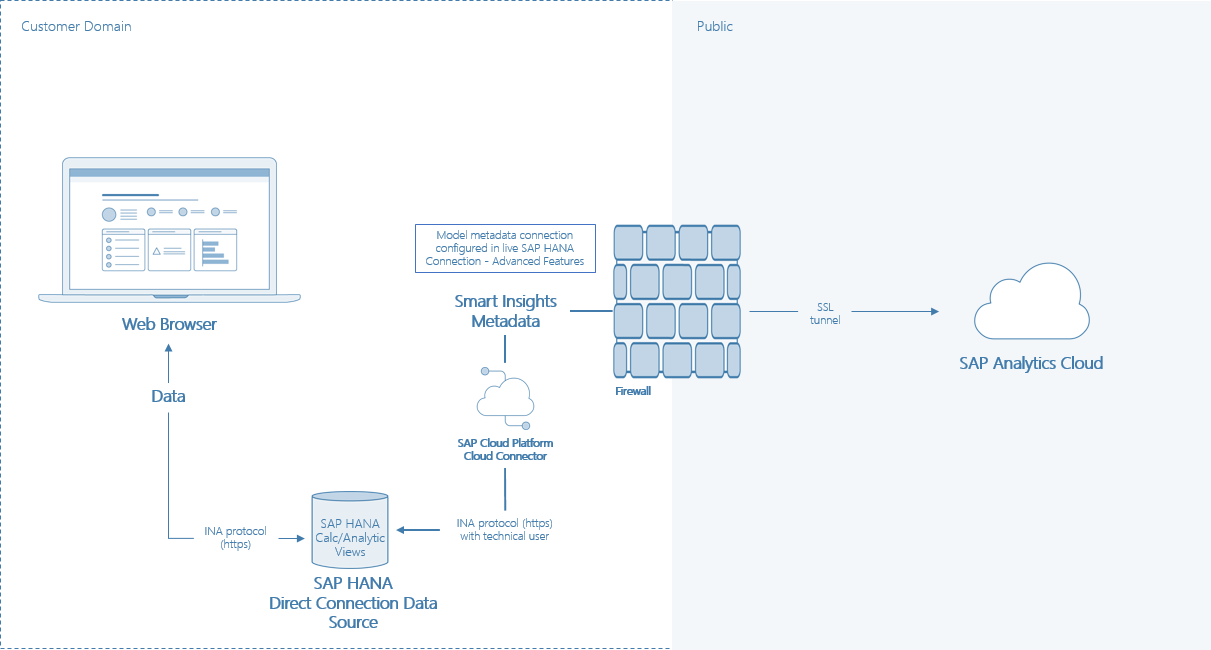Connecting to Live SAP HANA to Access Smart Insights - Overview
You can access Smart Insights on the models in your live SAP HANA direct connections.
Connection Types
Smart Insights works with live SAP HANA models using the Direct (CORS – Cross-Origin Resource Sharing) connection type. Direct connectivity is a simple approach as it doesn’t require any additional hardware, is easy to setup, and provides superior performance. For more information on the Direct connection type see the chapter called Direct Live Connection with CORS.
For more details on creating your live SAP HANA direct connections, see the chapter Live Data Connection to SAP HANA On-Premise Using a Direct Connection.
The most secure and recommended approach for a Smart Insights metadata connection to an on-premise SAP HANA system is through the Cloud Connector. The Cloud Connector is a component available with the SAP Business Technology Platform (BTP). The Cloud Connector needs to be deployed inside the corporate network, where there is direct access to the on-premise SAP HANA system. This creates a secure tunnel between the SAP HANA system’s HTTP InA endpoint and the system, where SAP Analytics Cloud is hosted.
Communication across the tunnel is secured using Transport Layer Security (TLS). It can be audited, monitored and controlled using the Cloud Connector administration user interface. The Cloud Connector removes the need to explicitly open any communication port in the firewall to the on-premise system. It acts as a reverse invoke proxy, as any communication is initiated by the Cloud Connector. The trust to the Cloud Connector is also configured on the SAP Analytics Cloud side to a specific SAP Analytics Cloud subaccount. The Cloud Connector component is available on Linux, Windows, and Mac OS X.
For more information, see Live Data Connections Advanced Features Using the Cloud Connector.
Overview of information flow between web browser, SAP Analytics Cloud, and your SAP HANA data source.
To benefit from Smart Insights on live SAP HANA models, it helps to understand the flow of information between the web browser, SAP Analytics Cloud, and your SAP HANA data source.
Let's take a look at how a typical setup works.
Overview diagram - connecting to live SAP HANA to access Smart Insights

In the Overview diagram - connecting to live SAP HANA to access Smart Insights, the Smart Insights Metadata connection is used to generate model metadata (statistics) about the SAP HANA modeling view, and store that metadata in SAP Analytics Cloud. The model metadata is generated against models on a live SAP HANA connection using a technical user and the other connection settings detailed in the New HANA Live Connection dialog. To be able to generate this model metadata, it's essential that the Enable model metadata generation checkbox is selected in the Advanced Features section of the New HANA Live Connection dialog. For more information about how to do this, see the chapter called Enabling the Generation of Model Metadata.
Smart Insights can then be used against the on-premise data accessed from a web browser inside your organization's domain.
-
Get/Post requests from the web browser to SAP Analytics Cloud are dedicated to metadata.
-
Get/Post requests from the web browser to the on-premise data source are dedicated to data. Data remains inside the customer domain.
For more information see the chapter called Live Connections Overview.
About Model Metadata
So, as we've already said, to use Smart Insights on live SAP HANA models, some model metadata needs to be generated first. This metadata helps Smart Insights work in your user interface.
The model metadata required to generate Smart Insights on live SAP HANA models is actually cardinality statistics that help to determine the most interesting candidates for further calculations related to Smart Insights.
Storing this metadata in SAP Analytics Cloud helps to speed up the responsiveness of Smart Insights, and improves the ability of the Smart Insights calculation to determine the most interesting dimensions and dimension members in a model.
HANA Workload Management (optional)
The load on an SAP HANA system can be managed by selectively applying restrictions and priorities to how resources are used, such as the CPU, the number of active threads and memory. Settings can be applied globally, or at the level of individual user sessions by using workload classes. The SAP HANA technical user used to generate Smart Insights Metadata can be assigned to a workload class.
-
Create a workload class controlling either the memory or the number threads. See more information for SAP HANA 1x or SAP HANA 2x (depending on your SAP HANA version).
-
Create a workload mapping to bind the workload class to the SAP HANA technical user used to generate Smart Insights Metadata. See more information for SAP HANA 1x or SAP HANA 2x (depending on your SAP HANA version).